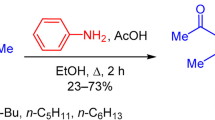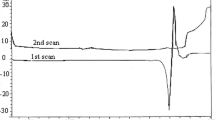Abstract
The kinetics of the desilylation of the triorganosilyl derivatives of some biologically active heterocyclic bases and uridine were investigated by1H NMR spectroscopy. A correlation was established between the relative rates of desilylation and the steric environment of the silicon atom. In trials on locomotor activity and muscular tone, the effect on memory processes, and the Porsolt test it was found that tris(tert-butylmethylsilyl)barbituric acid has higher sedative activity than barbituric acid. In contrast to uridine, 5′-O-tert-butyldimethylsilyluridine exhibits antitumor activity, suppressing the development of fibrosarcoma in human lungs (HT-1080) and fibroblasts in mice.
Similar content being viewed by others
References
E. Lukevits, S. Germane, I. Segal, and A. Zablotskaya, Khim. Geterotsikl. Soedin., No. 2, 270 (1997).
R. R. LeVier, M. L. Chandler, and S. R. Wendel, Biochemistry of Silicon and Related Problems, G. Bendz and I. Lindqvist (eds.), Plenum, New York (1978), p. 479.
E. Lukevits and A. Zablotskaya, Metalloorg. Khim.,6, 263 (1993).
R. R. LeVier, M. L. Chandler, and S. R. Wendel, Biochemistry of Silicon and Related Problems, G. Bendz and I. Lindqvist (eds.), Plenum, New York (1978), p. 485.
T. Nishimura, B. Shimizu, and I. Iwai, Chem. Pharm. Bull.,11, 1470 (1963).
G. H. Hakimelani, Z. A. Proba, and K. K. Ogilvie, Can. J. Chem.,60, 1106 (1982).
A. H. Beckett, D. C. Taylor, and J. W. Gorrod, J. Pharm. Pharmacol.,27, 588 (1975).
M. G. Voronkov, G. I. Zelchan, and É. Ya. Lukevits, Silicon and Life [in Russian], Zinatne, Riga (1978).
G. W. Peng, V. E. Marquez, and J. S. Driscoll, J. Med. Chem.,18, 846 (1975).
J. Grzybowska, J. Teodorczyk, R. Piekos, and A. Put, Sci. Pharm.,51, 301 (1983).
M. J. Samarasa, M. J. Perez-Perez, A. San-Felix, J. Balzarini, and E. De Clercq, J. Med. Chem.,35, 2721 (1992).
R. I. Freshney, Culture of Animal Cells, Wiley-liss, New York (1994), p. 296.
D. I. Fast, R. C. Lynch, and R. W. Leu, J. Leuk. Biol., 255 (1992).
R. J. Riddel, R. H. Clotthiew, and M. Balls, Fd. Chem. Toxicol.,24, 469 (1986).
E. Lukevics, I. Segal, A. Zablotskaya, and S. Germane, Molecules,2, 180 (1997).
V. V. Prozorovskii, M. P. Prozorovskaya, and V. M. Demchenko, Farmakologiya i Toksikologiya, No. 4, 497 (1978).
Additional information
For communication 4, see [1].
Latvian Institute of Organic Synthesis, Riga, Latvia. Translated from Khimiya Geterotsiklicheskikh Soedinenii, No. 9, pp. 1253–1258, September, 1998.
Rights and permissions
About this article
Cite this article
Lukevits, E., Segal, I., Birgele, I. et al. Silyl modification of biologically active compounds 5. Hydrolytic stability and biological activity of the trialkylsilyl derivatives of some heterocyclic bases. Chem Heterocycl Compd 34, 1076–1080 (1998). https://doi.org/10.1007/BF02251555
Received:
Issue Date:
DOI: https://doi.org/10.1007/BF02251555




